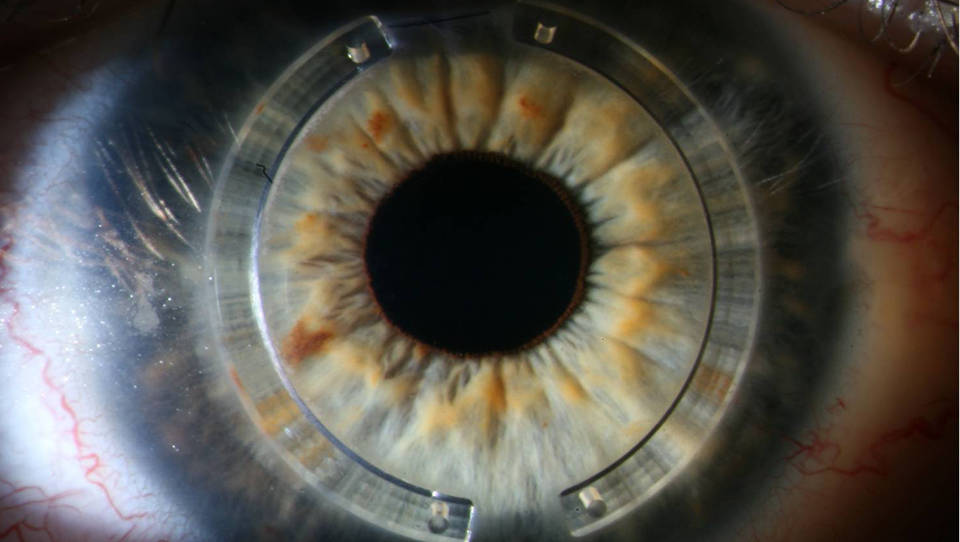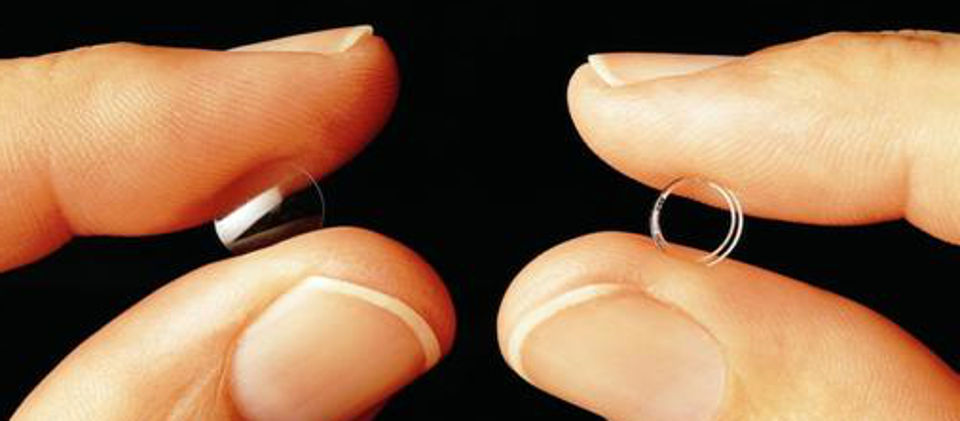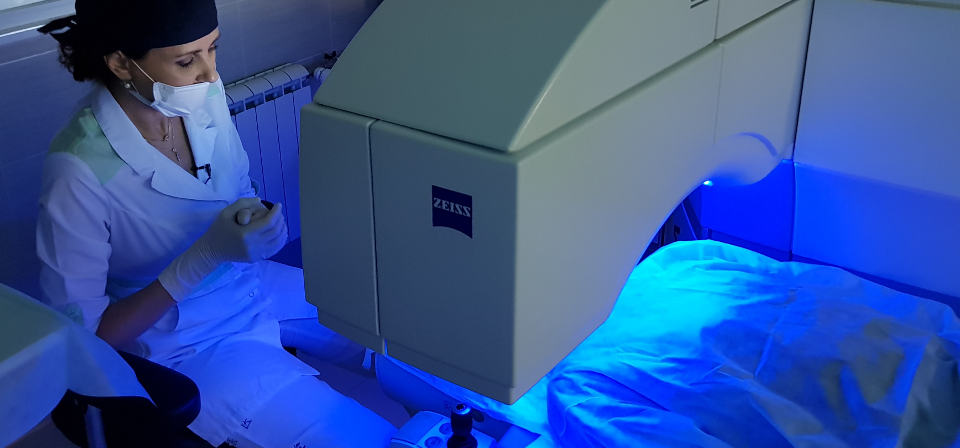Implantation of intrastromal corneal rings segments
Implantation of corneal segments (MioRing, Ferrara, KeraRing) is the newest method of surgical correction of astigmatism in keratoconus, which is an alternative to corneal transplant surgery.
Benefits of installing ICRS
- Here is a stabilization of keratoconus progression.
- There are no restrictions in physical activity.
- After implantation, you can quickly return to normal life.
- The rings can be adjusted and removed.
- The material of the rings is absolutely biocompatible with eye tissues.
- It is possible to use contact lenses.
- There are no age restrictions on the installation of intrastromal rings.

Indications for implantation ICRS
- Progressive keratoconus.
- Excimer laser-induced corneal ectasia.
- Irregular astigmatism of post-traumatic nature
- Irregular astigmatism after radial keratotomy.
- High myopic astigmatism thinning of cornea.
Contraindications
- Indications keratometry more than 75 D.
- Persistent opacities of the cornea in the optical axis of the eye.
- High astigmatism after keratoplasty.
- Hydrops of cornea.
- The presence of infection in the eye.
- Patients have unreasonable expectations.
Video of ICRS implantation
Types of intrastromal corneal ring segments
To date, two types of intrastromal rings are available: Intacs, which have a hexagonal section, and Ferrara Rings, which have the shape of a triangular prism. Implantation of rings can be made deep into the thickness of the cornea tissue (stroma). This operation takes place quickly, on an outpatient basis, with the instillation of an anesthetic drug.
For implantation, a special device is used – a vacuum layer dissector, which creates an arc-shaped pocket for the rings. According to the latest method for this purpose, a femtosecond laser is used. The mechanism of action of stromal rings is not exactly studied, but presumably their action consists in the ejection pressure, which is directed outward from the curvature of the cornea. Thus the flattening of the top of the cone and the cornea takes on a more natural form. According to earlier studies, an important role in this process belongs to the thickening of the adjacent to the segments of the overlying epithelium, which produces a significant leveling effect.

The difference between intrastromal corneal rings Ferrara Rings from Intacs is that They have a smaller radius of curvature (the second it varies from 2.5 to 3.5 mm, and the first is strictly 2.5 mm), as well as a lower probability of glare after their installation due to their prismatic shape. The reflection of any ray of light that hits the ring in the opposite direction occurs so that it does not fall into the field of view. Rings Ferrara Rings are located closer to the center of the cornea, and because of the smaller size can provide a more significant effect – to correct myopia to -12 DPT. When using Intacs rings such a large effect can not be achieved. Although it should be noted that with a large pupil diameter, some patients had the appearance of glare. In these cases, Intacs ring implantation is recommended.
How is the surgery provided
Implantation of intrastromal corneal ring segments into the thickness of the cornea tissue is the most modern and optimal method of treatment for keratoconus. The shape of the rings, which is measured in degrees of circumference, and in addition-their thickness in microns, localization and relative position is strictly individually determined by the shape of the cone, the size and position of its top.
Surgery for implantation of stromal rings is performed outpatient and takes about 20-30 minutes Anesthesia is provided locally by instillation, thus avoiding strain on the heart, blood vessels and other internal organs.
In another way, such operations are called "keraring". Its essence consists in the formation of two channels along the perimeter of the cornea, through which stromal rings are placed in the layers of corneal tissue. For some time after the operation, the doctors observe the patient, and then he returns home on the same day. With this surgical intervention, the rehabilitation period is minimal. To ensure faster recovery, the patient is scheduled to visit the doctor for a preventive examination.
The results of the surgery
In most cases, as a rule, the results of the operation are positive – after surgery, the degree of astigmatism is significantly reduced, visual acuity increases (with correction with and without glasses). To date, small groups of patients have been studied,but favorable outcomes of the operation are observed within 24-36 months. The best results keraring was observed at mild and moderate form of keratoconus.

Complications after ICRS implantation
Among the complications include perforation of the anterior chamber of the eye during surgery, infection, aseptic keratitis, postoperative extrusion (ejection) of the stromal ring and the absence of the expected effect of the operation. If necessary, the problem segments can be easily removed, which will allow the cornea to return to its original state, which was before the operation. According to studies, the removal of stromal rings for any of the above reasons is necessary in about 10% of cases. However, this is not an obstacle to subsequently carry out lamellar (DALK) or penetrating (PKP) keratoplasty.
Prices for implantation of intrastromal corneal ring segments
The cost of the operation consists of the price of the rings themselves (expendable material) and the work of the ophthalmic surgeon for their direct installation in the operating room.
- Implantation of corneal segments femtoproject 1 category of complexity - 100 000 rubles (1 550 us-dollars) per eye
- Implantation of corneal segments femtoproject 1 category of complexity - 130 000 rubles (2 000 us-dollars) per eye




Our center implantes ICRS at the 4th stage of keratoconus in some cases (if the if the thickness of the cornea allows it), however, it is possible to talk about the possibility of this procedure in a particular case only after examination.
Yes, after previous corneal cross-linking, implantation of intrastromal segments is possible, but not earlier than 6 months.
1992. - radial keratotomy and 2004. - LASIK? It is said that after keratotomy ring is not put?
Indeed, the presence of significant cicatricial changes in the cornea (including after a previously performed radial keratotomy) may be a contraindication to the implantation of intrastromal segments, especially with a femtosecond assist.
To answer Your question, it is necessary to understand the condition of the cornea: for this purpose, such examinations as optical coherence tomography (OCT) of the cornea are carried out.
After that, we can talk about the possibility/impossibility of ICRS implantation in a particular case.
Corneal thickness min 466. What examination can accurately say that there are these cracks? Which segments do you use Intacs or Ferrara rings?
To solve Your question, you need to be examined by biomicroscopy of the endothelial layer of the cornea (the clarify and cracks microstrip endothelium).
We use all types of segments and select the best solution individually.
In your situation it is better to make crosslinking, ICRS will always have time to deliver, may be progress of keratoconus will be over.
The period of rehabilitation after each procedure is quite short (up to two weeks) - at this time it is necessary to instill drops.
As for sport: regardless of whether the person has been implanted corneal segments or not, we recommend the use of protective equipment (helmet), as blows to the eyeball can cause serious problems not related to the cornea (contusion and retinal detachment, rupture of the iris, dislocation of the lens, etc.).
Local anesthesia (by drops) is used during the procedure of implantation of intrastromal segments.
There is no pain, some patients may have some mild discomfort.
In 2017, rings will be installed in August. But the doctor didn't prescribe any drops, treatment before surgery is not advised on account of what alternative to glasses, such as lenses, can be found so I could still run until Aug.
While I wait until August, there won't be any deterioration?
Implantation of intrastromal corneal ring segments (ICRS) are carried out mainly for refractive purposes (with therapeutic cross - linking is performed - it is not clear whether You have already had this procedure) - in order to improve the patient's vision.
Up to this point, you can go to the office of contact vision correction, where hard contact lenses are selected for keratoconus or contact another medical institution (including our ophthalmological center), where you do not have to wait so long for the implantation of segments.
About drops - a particularly significant effect of them is not presented, but You can use as a" supportive treatment " (in consultation with your doctor) such drops as Taufon, Taurine, etc.
Complex myopic astigmatism what surgery should be done?to regain sight?
To improve vision in keratoconus (including in the presence of unadjusted astigmatism) recommend the implantation of keraring (intrastromal rings) - this significantly improves the vision of patients.
In order to combat the progression of the disease, the procedure of corneal cross-linking is used (more about this you can read here: https://en.keratoconusa.net/treatment/crosslinking.html).
As for the operation of installation of intrastromal segments (IСRS), it is carried out on an outpatient basis (hospitalization is not required), postoperative recovery period (rehabilitation) - up to two weeks.
Usually, here is no dislocation of corneal segments after their implantation: they are securely fixed in the corneal stroma.
But some times they can displace on corneal surface, such condition is calles "extrusion" and requed surgycal tratment.
In the early postoperative period, visual acuity may fluctuate (at least 2 weeks), because during the implantation of segments, corneal trauma occurs and the subsequent inflammatory process takes place. Therefore, at first sight is unstable, there may be jumps in one direction or another, double vision.
Gradually, vision should stabilize at values higher than those that were before the ICRS.
Disease-keratoconus 3 degrees.
Could you tell me please, after crosslinking can be will replace / to remove rings?
And another question: after installing the ring (more than a year ago) and eyesight has not deteriorated but also not improved. Does it happen?
Simply many write, that vision check is improving.
Yes, intrastromal corneal segments can be extracted from the stroma of the cornea, if there are indications (the presence of an inflammatory process, etc.) - there are usually no difficulties here.
Regarding the second question: indeed, the main purpose of the installation of rings - refractive (improving the patient's vision, by correcting the shape of the cornea). As a rule, there is no improvement in vision with high degrees of keratoconus or concomitant eye diseases (retinal dystrophy, lens opacity, etc.).
My son was operated on by ICRS on may 11, today is may 30, but there are no changes. he can't see with his left eye anything, what should we do? maybe it's too early to restore vision or it will not recover at all?
In the early postoperative period after implantation of corneal segments, vision is usually unstable. Forth (after 2-3 weeks) - should be improvement. Specifically, the situation Can be explained to you by the attending physician, after a control examination (for example, on a planned month after the implantation of ICRS).
If you are concerned about this, we recommend that you contact a keratoconus specialist before the scheduled consultation.
1) 2 days after surgery implantation of ICRS - this is not the time to determine visual acuity, because there is swelling of the cornea, is the use of drugs.
2) On the sequence of crosslinking and installation of segments - you can do so and so. More often make the first installation, then crosslinking (because the surgeon is simply easier to insert keraring into the elastic cornea) and the results are better.
I had femtoimplantation of segments 22.09 vision immediately improved significantly on his left eye, light objects to fork . I hope that it will pass, and the almost happy!
Surgery on the cartilaginous part of the nose without affecting the bone.
There is not a hindrance, and even supplements. Usually patients with keratoconus, in the end, do both (the sequence may be different, often put a ICRS first, if there are serious violations of refraction), then cross-linking.
in order:
1) you will be able to Start work related to visual cativity as soon as you feel comfortable. Have someone this 2-3 days, have someone week.
2) Lenses will have to pick up again, because after the installation of intrastromal segments is changed and the refraction and the curvature of the cornea. Use soft contacts better when stop dripping drugs and leave inflammation (about a month).
The price is for 1 eye.
Yes, we successfully implant ICRS in stage 2 keratoconus. But, in any case, initially it is necessary to understand the exact parameters of the cornea (primarily thickness).
Contact us - we will be glad to help you!
We recommend waiting for childbirth and the end of breastfeeding -and implanted corneal segments only after that, because the accuracy and stability of the results will be more high.
+ in the postoperative period it will be necessary to apply antibacterial and anti-inflammatory drops.
The operation is painless (performed under local anesthesia by drops).
In the first few days after corneal installation there may be some discomfort and instability of vision.